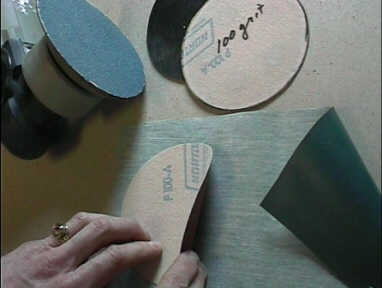
By Tom Pawlak — GBI Technical Advisor
I recently ran out of sandpaper for my 5″ diameter random orbital sander, and needed only a few more sanding disks to finish the project. While my sander is equipped for the hook-and-loop style sanding disks, I had only PSA (pressure sensitive adhesive) style sanding disks. These did not stick well to the pad on the sander, and within a minute or two they would fly off, leaving me frustrated. I finished my project by gluing the PSA disks to worn out hook-and-loop disks with contact cement. This actually worked quite well.
The following week, I went to our local auto paint supply store to look for a conversion pad for my sander. I wanted a pad that would allow me to switch from one type of sand paper to another. I had hoped to use up my PSA sanding disks without purchasing a whole new backing disk for the sander. I needed a conversion pad that had the hook-and-loop fuzz on one side and a smooth surface on the other. This would allow me to use up my supply of PSA sand paper and easily switch back to the hook-and-loop style later. The counter man thought it was a good idea but he had not seen anything like it in any of his sanding equipment catalogs. I was surprised to find that no such conversion pad existed.
Necessity being the mother of invention, I went home and made my own. After all, the hook-and-loop style sandpaper disks cost 50 cents each or more while the sticky back disks cost less than half that amount.
Since then, I have made several — one for each of the sanding grits I use on a regular basis. This way, the PSA sanding disks are not torn or damaged when switching from one grit to another because the sand paper is not removed from the pad until it is worn out and dull.
I made my conversion pads by gluing a piece of cloth-backed vinyl to the grit side of an old hook-and-loop sanding disk. I used our G/5 Five Minute Adhesive to glue the two together but contact cement would work well too. Not knowing what to expect, I mounted the conversion pad onto the sander. Onto that I mounted a piece of 80-grit PSA paper and gave the sander a try. I was very pleased with how the whole setup performed.
If you’re budget-minded like I am, and use a 5″ or 6″ random orbital sander with the hook-and-loop sand paper, consider making your own set of conversion pads for your sander. It will allow you to use the less expensive sanding disks and will get you by in a pinch if your hardware store is out of the hook-and-loop style sand paper.
Here’s what you need to make your own:
- A worn out Velcro backed sanding disk
- Vinyl fabric with a smooth face and an exposed cloth back side
- G/5 Five Minute Adhesive or contact cement
- 1/2″ to 3/4″ thick plywood pieces slightly larger than the sanding disks
- Wax paper or plastic sheets
- Your conversion sanding pad is now ready to use.Begin by applying G/5 Five Minute Adhesive to the cloth side of the vinyl. Note: G/5 produces a fairly rigid conversion pad. Substituting contact cement will produce a more flexible conversion pad.
- Place the vinyl against the old sanding disk (sand paper side) and sandwich them between two plastic covered pieces of plywood. Clamp the assembly between c-clamps or a vise until cured.
- Remove the clamps and peel away the plywood and plastic layers.
- Trim off excess vinyl with scissors to match the original sanding disk.
- Drill out the dust pickup holes in the pad that have been covered with vinyl if your sander is equipped for dust pickup.
Before mounting the pad on the sander, I find it helpful to write the grit size (60, 80 or 120-grit) on the fuzzy side of the conversion pad so that you will know what PSA sand paper is attached to the conversion pad. This eliminates the potential for damaging the PSA paper when peeling the sandpaper back to identify the grit.
High quality hook-and-loop sanding disks should ideally be used to make these conversion pads. The “fuzz” wears off of cheaper sanding disks, after applying 2 or 3 of the PSA sanding disks. The premium hook-and-loop sanding disks are considerably more durable.





